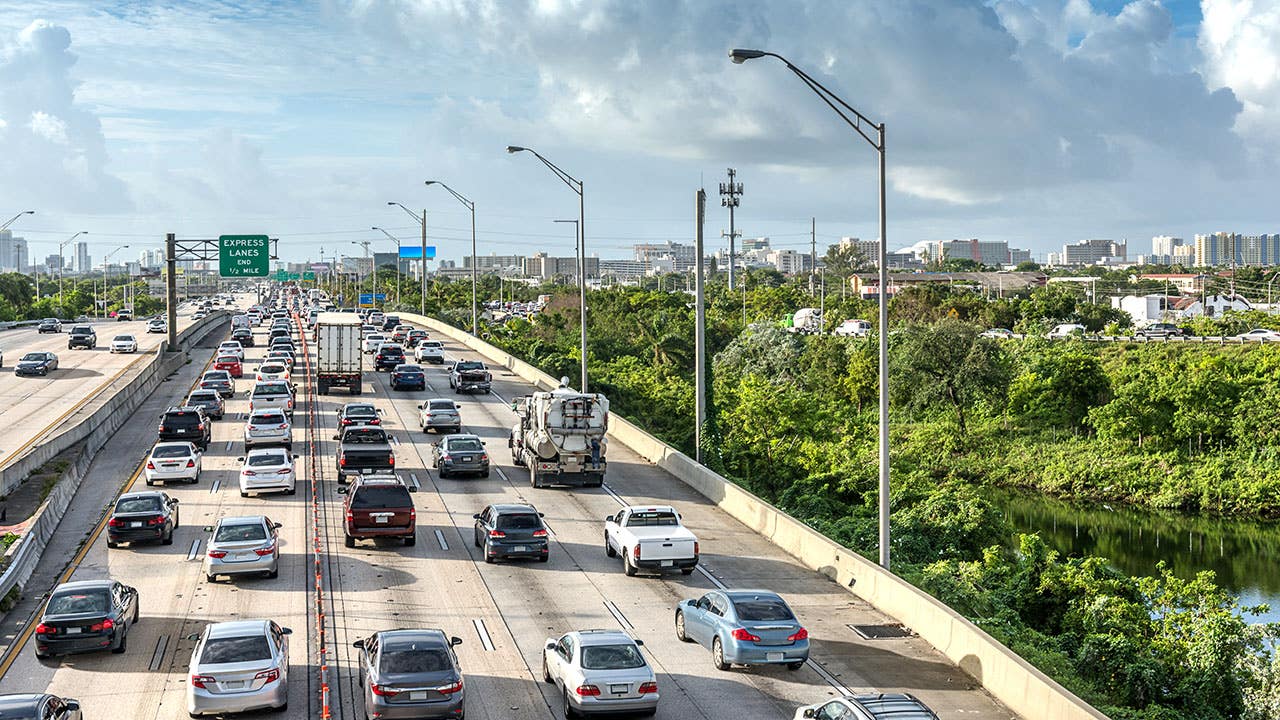Car insurance for high-risk drivers in Florida

The Bankrate promise
At Bankrate, we strive to help you make smarter financial decisions. To help readers understand how insurance affects their finances, we have licensed insurance professionals on staff who have spent a combined 47 years in the auto, home and life insurance industries. While we adhere to strict , this post may contain references to products from our partners. Here's an explanation of . Our content is backed by Coverage.com, LLC, a licensed entity (NPN: 19966249). For more information, please see our .
Floridians pay some of the highest car insurance rates in the country, and drivers who find themselves in a high-risk group typically pay even more. You could be deemed high risk if you receive a severe moving violation such as a DUI or multiple speeding tickets. Insurance companies base auto rates on the risk you pose, so high-risk incidents usually drive up your premiums. Some providers can choose to nonrenew high-risk drivers, potentially limiting your coverage options. Bankrate’s insurance editorial team compiled all you need to know about finding high-risk auto insurance in Florida.
High-risk car insurance rates in Florida
Generally, car insurance companies use about a dozen different rating factors to determine your premium. Of these factors, your driving record is one of the most significant. Usually, a conviction or accident of any type (even a not-at-fault accident) can cause your average to increase. However, certain kinds of driving activity may impact your premium more than others.
Below, we’ve listed some of the most common high-risk scenarios that increase average Florida car insurance premiums. We’ve included average premiums for some of the largest car insurance companies by market share in the state to give you an idea of how rates vary between carriers. It is important to note that your other rating factors will also influence your premiums, and some of the listed carriers may not be willing to extend coverage to certain high-risk drivers.
Rates after a speeding ticket in Florida
Although speeding tickets are fairly common, you’ll usually see an increase in your car insurance premium after a speeding conviction. How much your rate goes up after a speeding ticket in Florida can vary. Generally, the faster you were going over the speed limit, the more severe the infraction. The more severe the infraction, the more your premium might go up. Where you were speeding — in a school or construction zone, for instance — can also play a part.
| Car insurance company | Florida avg. premium before a speeding ticket | Florida avg. premium after a speeding ticket | Percentage difference |
|---|---|---|---|
| Allstate | $4,082 | $5,140 | 26% |
| Geico | $3,290 | $4,489 | 36% |
| Progressive | $3,034 | $3,978 | 31% |
| State Farm | $3,250 | $3,765 | 16% |
Rates are annual averages for full coverage
Companies that are the cheapest prior to a violation are sometimes the most expensive afterwards. Other companies might increase rates for people who take advantage of discounts or safe driving programs. As such, those with a less-than-perfect driving record may need to shop around to find the best car insurance company for their unique circumstances.
Rates after an accident
As with speeding convictions, the severity of your accident can dictate how much of a premium increase you may see. How much property damage did you cause, and were there any injuries? Additionally, your past driving history can also contribute, especially if you have a history of at-fault accidents and driving convictions.
| Car insurance company | Florida avg. premium before an accident | Florida avg. premium after an accident | Percentage difference |
|---|---|---|---|
| Allstate | $4,082 | $6,003 | 47% |
| Geico | $3,290 | $4,341 | 32% |
| Progressive | $3,034 | $4,519 | 49% |
| State Farm | $3,250 | $4,351 | 34% |
Rates are annual averages for full coverage
Rates after a DUI in Florida
A DUI conviction is among the most severe infractions a driver can have on their driving record. In fact, some companies may refuse to sell a policy to a driver convicted of a DUI. Although the average rates below could provide a helpful baseline, you may want to contact companies directly if you have a DUI on your record.
| Car insurance company | Florida average annual premium for full coverage before a DUI | Florida average annual premium for full coverage after after a DUI | Percentage difference |
|---|---|---|---|
| Allstate | $4,082 | $6,499 | 59% |
| Geico | $3,290 | $5,142 | 56% |
| Direct General | $5,128 | $5,385 | 5% |
| Progressive | $3,034 | $3,408 | 12% |
In addition to increased premiums, the state of Florida will also likely require you to carry a certificate of financial responsibility called an FR-44 after a DUI conviction. To qualify for an FR-44, you will have to carry at least $100,000 in bodily injury liability coverage per person and $300,000 in bodily injury liability coverage per accident. Although the FR-44 itself won’t cause your premium to go up (outside of the filing fee), these higher liability limits almost certainly will.
Rates for drivers with bad credit
Some states ban or restrict car insurance companies from using your credit-based insurance score to calculate your rate, but not Florida. This means that Floridians can expect their credit score to have a major hand in how much they pay for coverage.
Statistics show that drivers with bad credit file more claims than drivers with good or excellent credit. To compensate for this heightened risk, car insurance companies typically charge drivers in the poor credit tier some of the highest rates.
| Car insurance company | Florida average annual premium full coverage premium for a driver with good credit | Florida average annual premium full coverage premium for a driver with poor credit | Percentage difference |
|---|---|---|---|
| Allstate | $4,082 | $6,620 | 62% |
| Geico | $3,290 | $5,887 | 79% |
| Progressive | $3,034 | $4,959 | 63% |
| State Farm | $3,250 | $14,354 | 342% |
You might notice that the average premiums in this table are even higher than those after a DUI conviction. It can be challenging to find affordable car insurance for bad credit, but it may be possible with some comparison shopping.
Rates after a lapse in coverage
Driving without insurance in Florida is illegal. If you have a lapse of car insurance in Florida, the state could suspend your license and force you to carry an FR-44. You might also be deemed a high-risk driver and see an increase in your average premium (although this can depend on your prior driving history and may vary from company to company).
| Car insurance company | Florida average annual premium for full coverage before a lapse in coverage | Florida average annual premium for full coverage after after a lapse in coverage | Percentage Difference |
|---|---|---|---|
| Allstate | $4,082 | $6,547 | 60% |
| Geico | $3,290 | $3,286 | 0% |
| National General | $5,128 | $5,128 | 0% |
| Progressive | $3,034 | $3,012 | -1% |
| State Farm | $3,250 | $3,252 | 0% |
Legality aside, car insurance provides vital financial protection. Comparing rates to find the most robust policy that you can fit into your budget could save you from devastating out-of-pocket expenses if you cause an accident without sufficient coverage.
Rates for teen drivers
Being a safe driver doesn’t happen overnight. It takes time and experience to develop strong defensive driving skills. Teens are new to the road and tend to engage in more risky driving behavior, such as distracted driving, speeding and not wearing a seat belt. As a result, car insurance companies usually place drivers under the age of 25 in the high-risk auto insurance category and price their policies accordingly.
Drivers typically need to be 18 years old to have their own insurance policy. To get an accurate depiction of the cost of car insurance for new drivers, we’ve included the average rates for 16-year-old drivers added to their parents’ policy. The premiums below reflect the cost for three drivers (the child and two parents).
| Car insurance company | Florida average annual premium for full coverage |
|---|---|
| Allstate | $6,500 |
| Geico | $6,864 |
| National General | $11,638 |
| Progressive | $5,043 |
| State Farm | $6,363 |
Many companies offer a variety of teen driver discounts, such as good student, away at school and drivers training. Nonetheless, the best thing you can do is ensure your teenager learns good driving habits so their driving record stays clean (and so they stay safe).
Who is a high-risk driver?
A high risk driver is typically someone who has one or more of the following:
- Speeding tickets
- At-fault accidents
- Living in a high risk area
- Being a teen driver
- DUI
- Bad credit
- Lapse in coverage
- High-risk vehicle type
Drivers who meet their insurance company’s definition of a high-risk driver are usually charged more for auto coverage to offset the risk associated with their potential for future loss. While high-risk auto insurance in Florida typically just means drivers pay more for the same coverage they had before, it is possible their carrier may drop them altogether after a serious violation.
How to lower your rate if you are a high-risk driver
Each insurance company has its own unique underwriting criteria that determine if a driver is considered high-risk. One company might consider drivers with three speeding tickets high risk, while another may set this classification after just two speeding tickets. While one car accident shouldn’t drastically alter which risk pool you are in, one accident that involves drunk driving can. Even as a high-risk driver, you may be able to lower your rates using the following strategies:
- Shop around: As shown above, car insurance companies charge drivers different rates, so getting several quotes will give you a better idea of your options.
- Compare discounts: Most insurance companies offer multiple discounts to get your premium down, and while a lot of companies offer many of the same options, you can often save more with certain ones.
- Consider your vehicle: The make and model of your vehicle will impact your rate, and new cars usually cost more to insure. If you’re already in the market for a new vehicle, you could save money by driving an older car or one with a high safety rating.
- Improve your credit: People with low credit scores are more likely to file claims than those with high credit scores. Increasing your credit score and asking your insurance provider to rerun your credit information to potentially lower your premium in Florida.
- Consider your deductibles: Collision and comprehensive insurance both have deductibles. Choosing a higher deductible will lower your premium, but you would have to pay more out of pocket if you need to file a claim.
- Drive safely: Even if you have a few dings on your record, avoiding tickets and accidents may bring you out of the high-risk rating category after a few years. Enrolling in a telematics program may also help you demonstrate to your insurer that you’re maintaining safe habits behind the wheel.
Frequently asked questions
-
-
The average cost of car insurance in the U.S. is $2,543 per year for full coverage and $740 for minimum coverage. That is significantly lower than the average annual rate for car insurance in Florida, which is $3,945 per year for full coverage and $1,308 for minimum coverage. However, those are just the average rates. Your rates will vary depending on the coverage selections and limits you choose. Plus, other factors, like your ZIP code, vehicle and driving history will also have an impact on your rates.
-
The best car insurance company for Florida drivers depends on what each driver needs from their insurance provider. Progressive tends to have the cheapest average rates for high-risk car insurance in Florida, but price isn’t always the determining factor. Some drivers prefer working with an agent directly, so maybe State Farm or Farmers would be a better fit. Policyholders who prefer digital tools and affiliation discounts may find Geico a better option. Identifying what features you value most in a car insurance company can be the first step toward finding a provider that meets both your coverage and budgetary needs.
-
Drivers in Florida who are convicted of a DUI are likely to receive a policy surcharge for three years and need to file an FR-44 during that time frame. Once the surcharge period is over, drivers should see a decrease in their rates, but insurance companies can underwrite for the risk associated with a DUI for several more years. In terms of a criminal record, first and second DUI offenses are misdemeanors and additional DUI convictions are felonies in Florida. In both cases, they will stay on your criminal record forever unless expunged or sealed.
-
Car insurance is a legal requirement in the Sunshine State. Someone who is required to purchase car insurance needs to be able to do so regardless of their driving history. However, since insurance companies set the rules for whom they can and can’t insure, there are drivers who cannot secure coverage in the standard market. The Florida Automobile Joint Underwriting Association (FAJUA) provides universal access to car insurance for drivers who otherwise can find a policy. Every auto insurance company licensed to issue liability or physical damage insurance in Florida is a member of the FAJUA and contributes funds to a shared pool to fulfill claims made by FAJUA policyholders. This is a way of spreading the risk among all insurance providers. FAJUA policies are typically much more expensive than a policy through a private high-risk auto insurance provider and is seen as a “last resort” insurance option.
-
Methodology
Bankrate utilizes Quadrant Information Services to analyze 2024 rates for ZIP codes and carriers in all 50 states and Washington, D.C. Rates are weighted based on the population density in each geographic region. Quoted rates are based on a 40-year-old male and female driver with a clean driving record, good credit and the following full coverage limits:
- $100,000 bodily injury liability per person
- $300,000 bodily injury liability per accident
- $50,000 property damage liability per accident
- $100,000 uninsured motorist bodily injury per person
- $300,000 uninsured motorist bodily injury per accident
- $500 collision deductible
- $500 comprehensive deductible
To determine minimum coverage limits, Bankrate used minimum coverage that meets each state’s requirements. Our base profile drivers own a 2022 Toyota Camry, commute five days a week and drive 12,000 miles annually.
These are sample rates and should only be used for comparative purposes.
Incidents: Rates were calculated by evaluating our base profile with the following incidents applied: clean record (base), at-fault accident, single speeding ticket, single DUI conviction and lapse in coverage.
Credit-based insurance scores: Rates were calculated based on the following insurance credit tiers assigned to our drivers: “poor and good (base).” Insurance credit tiers factor in your official credit scores but are not dependent on that variable alone. Four states prohibit or limit the use of credit as a rating factor in determining auto insurance rates: California, Hawaii, Massachusetts and Michigan.
Teens: Rates were determined by adding a 16-year-old teen to their 40-year-old married parents’ policy. The rates displayed reflect the total cost of a driver this age added to their parents’ policy.
Related Articles



